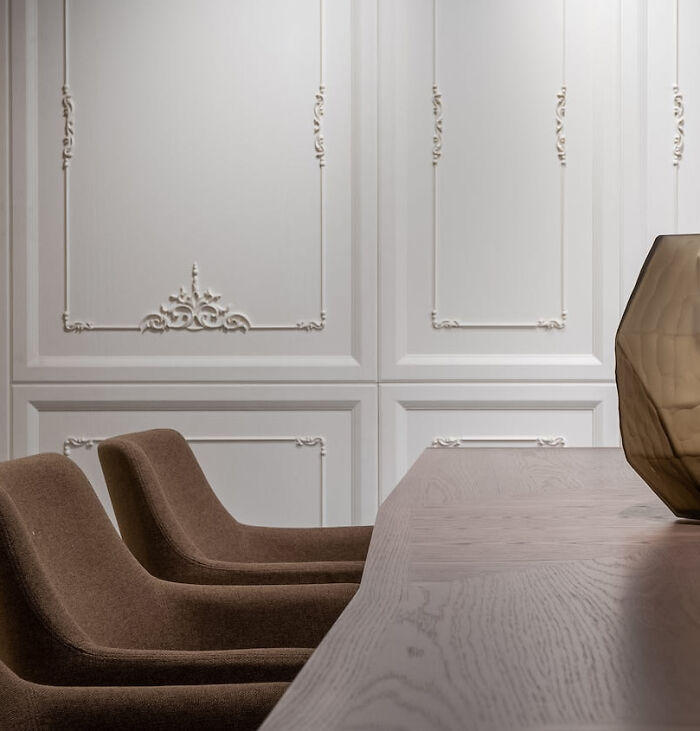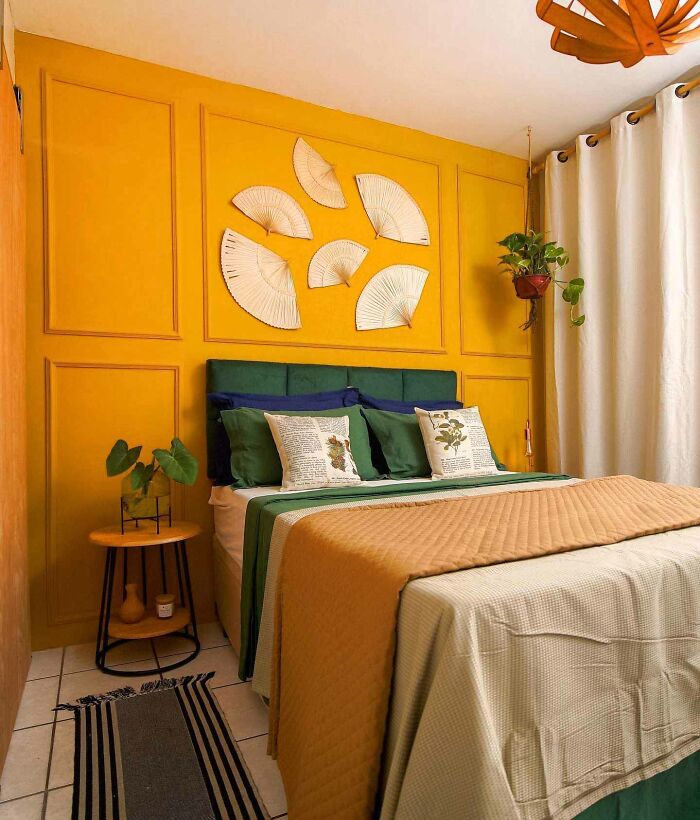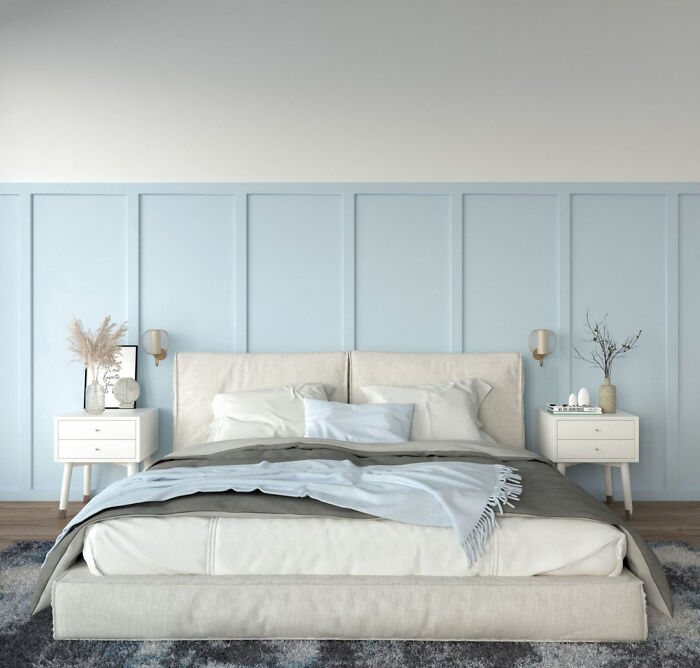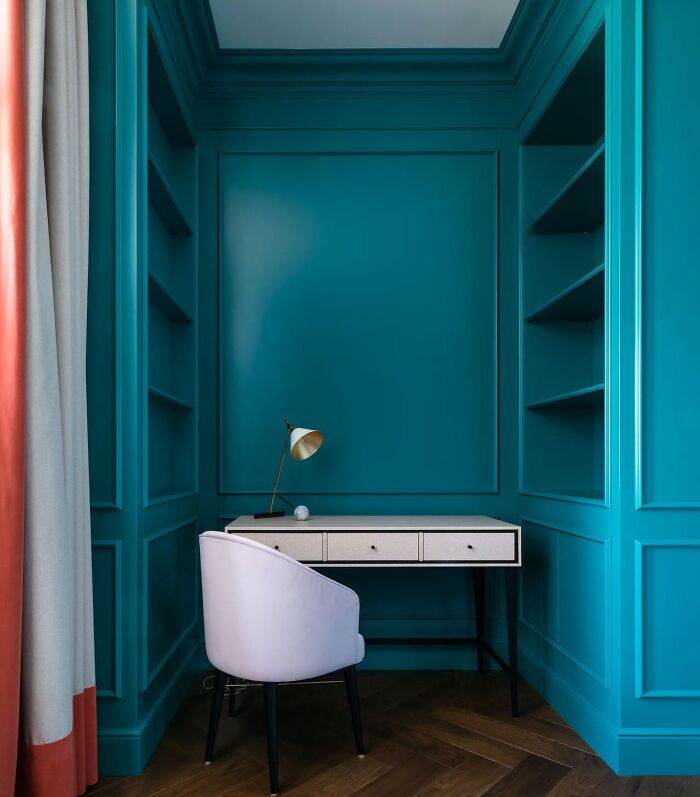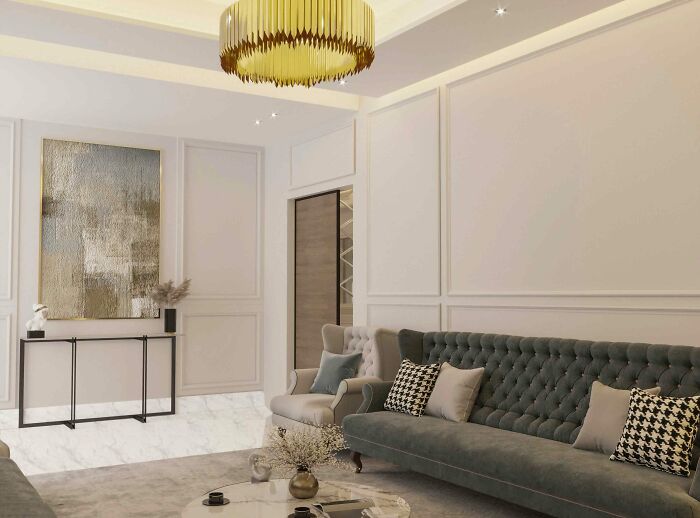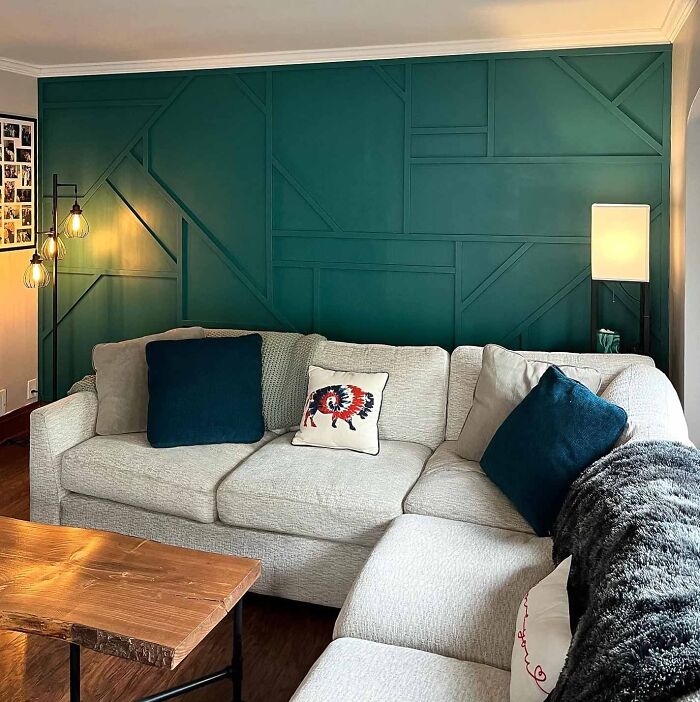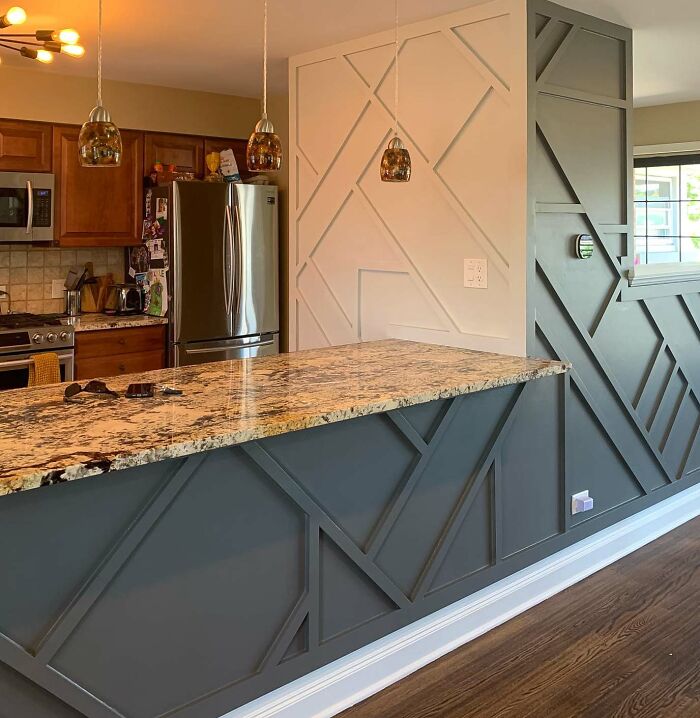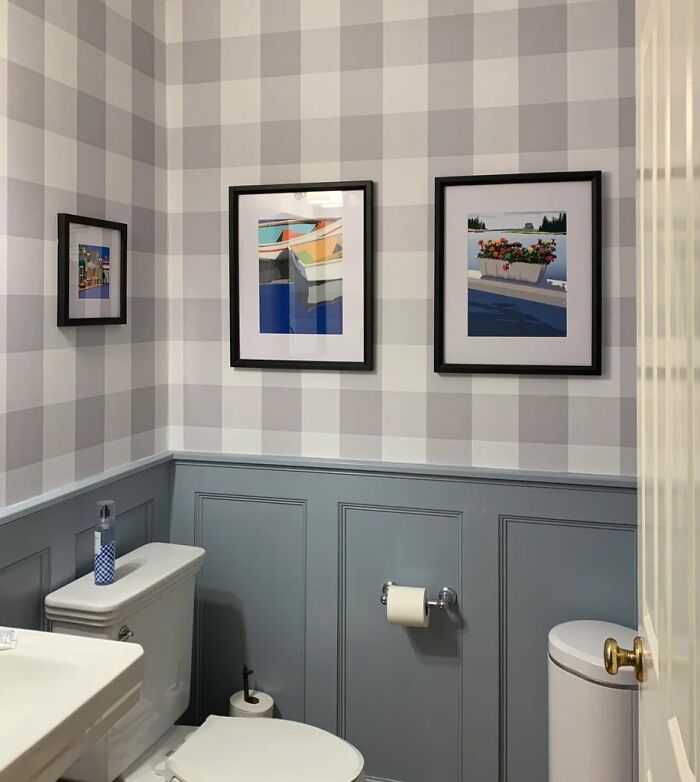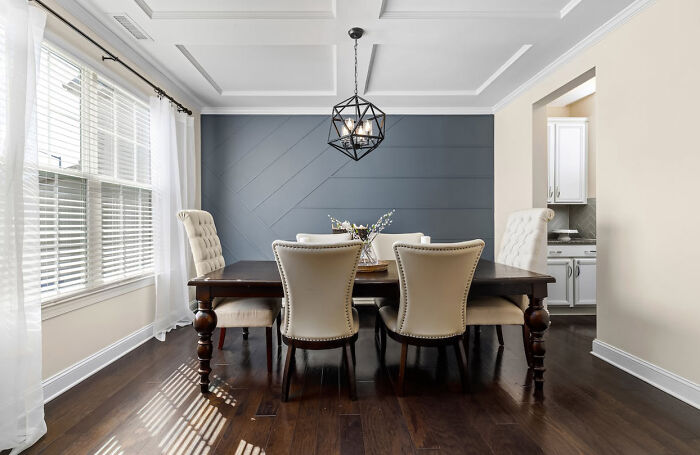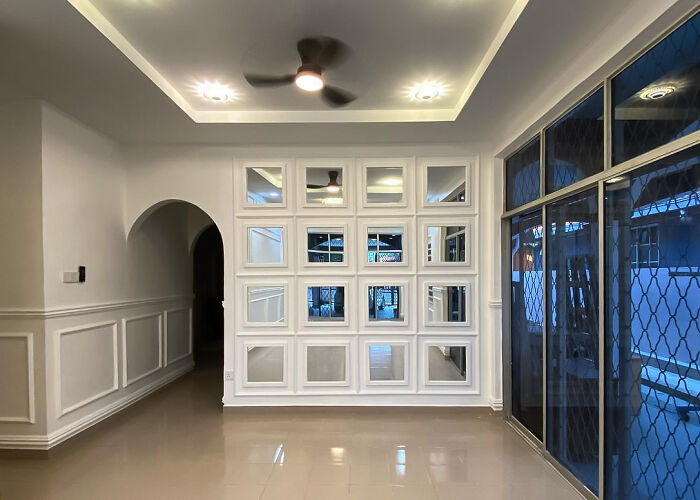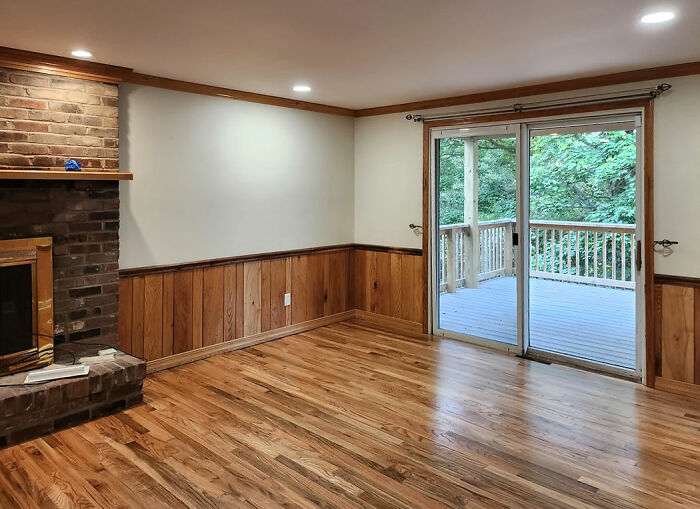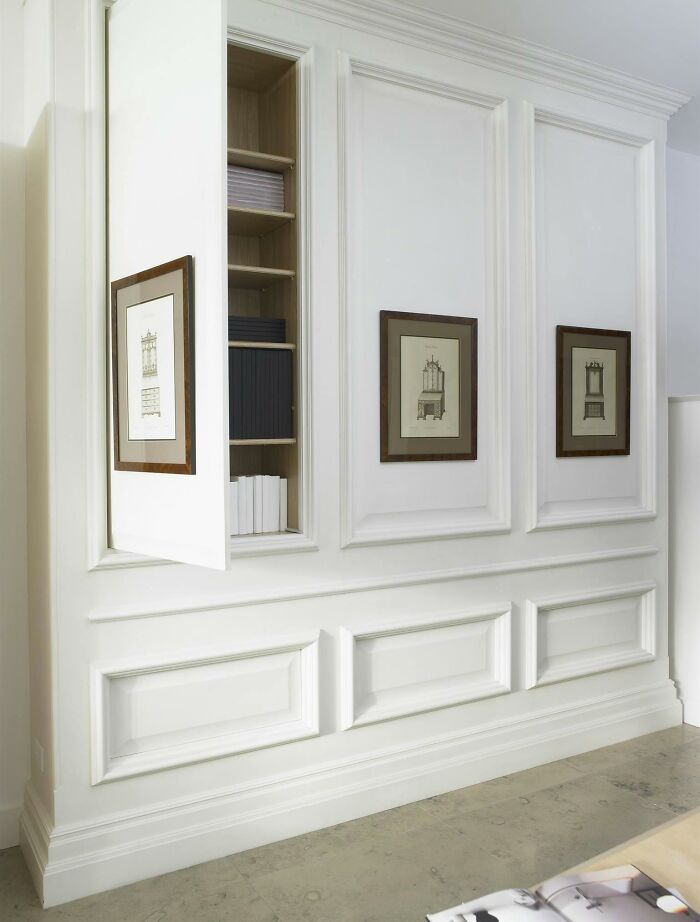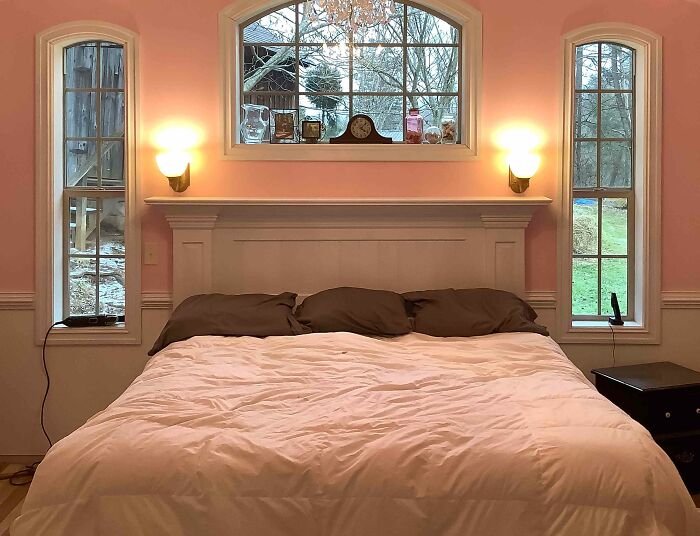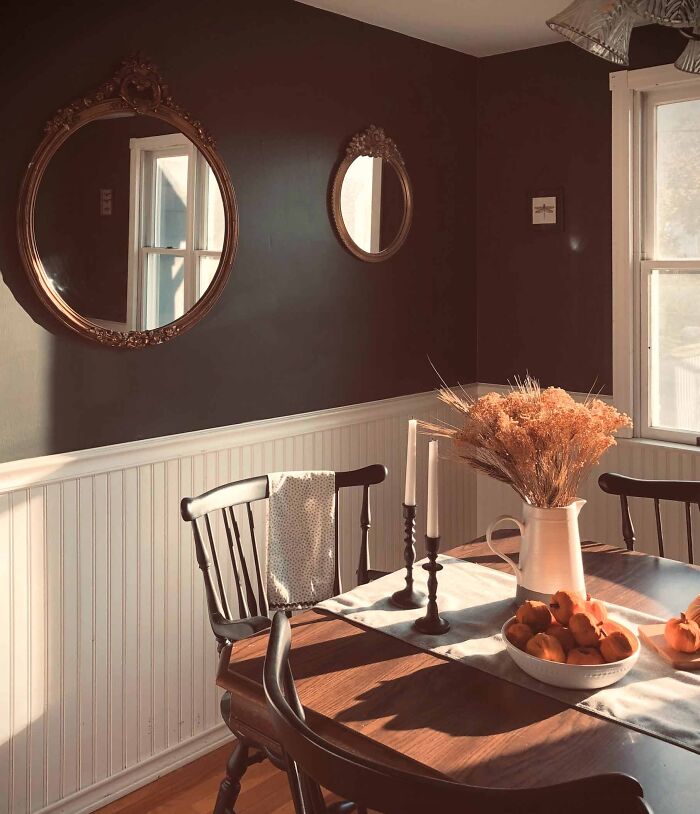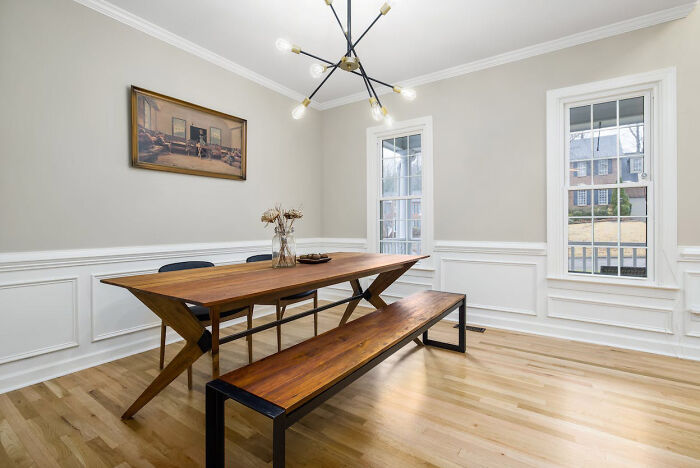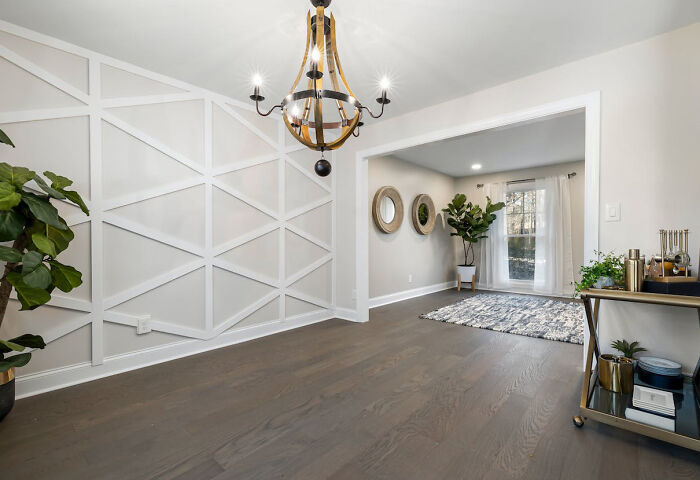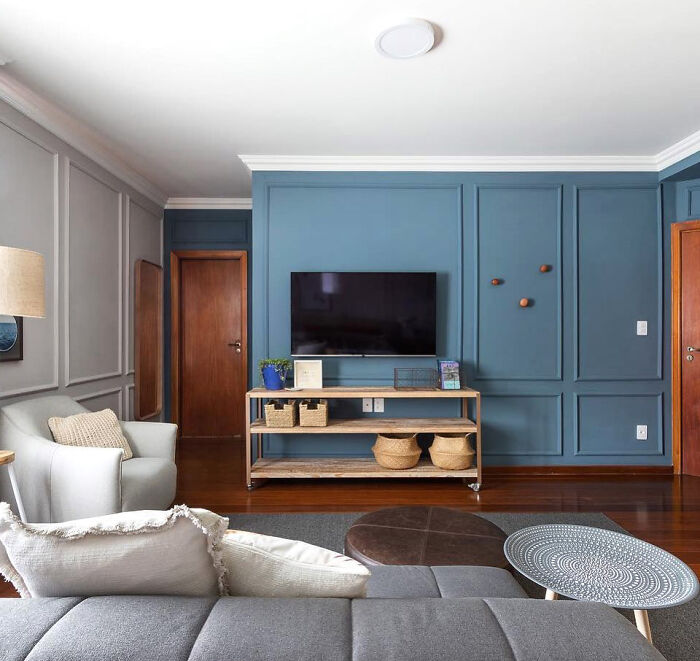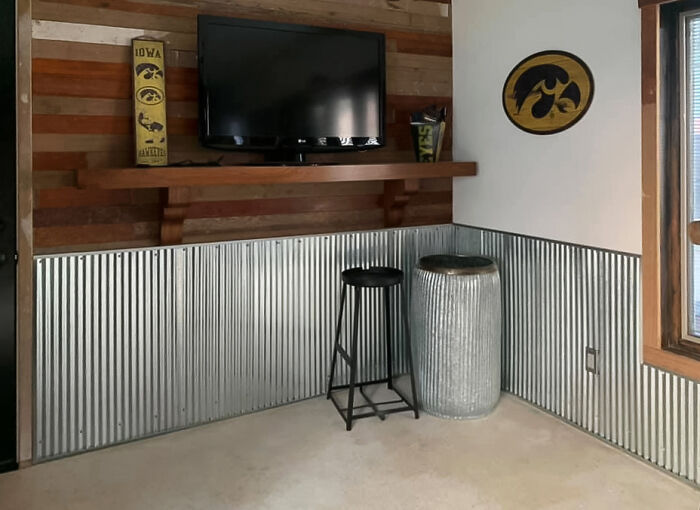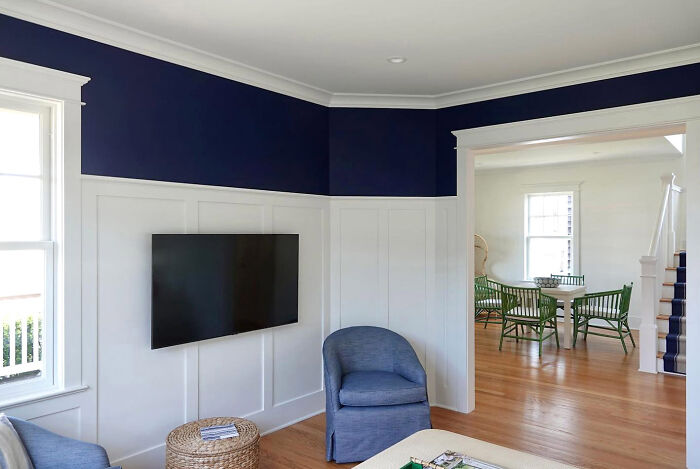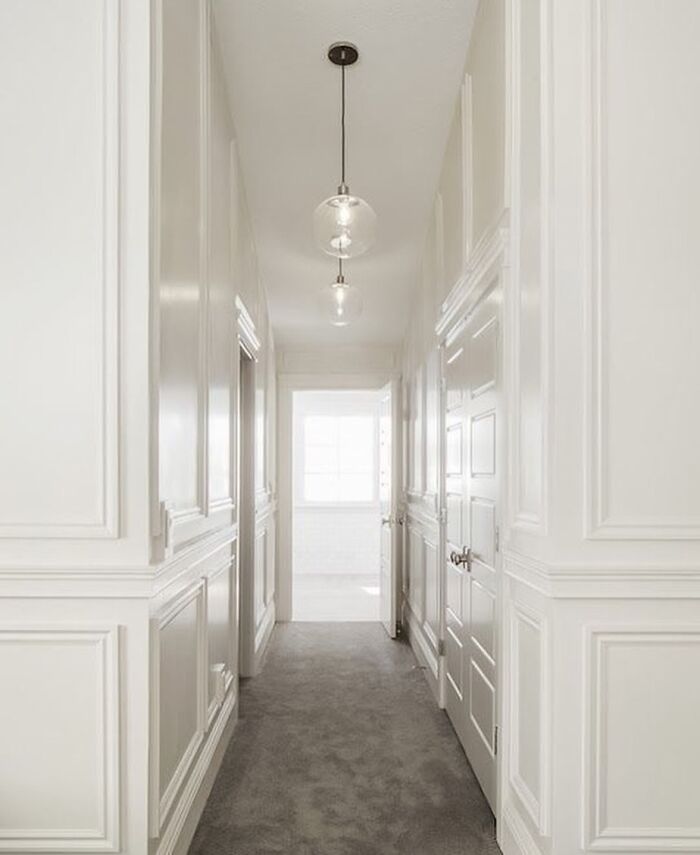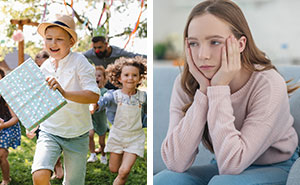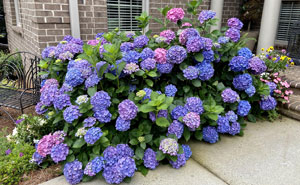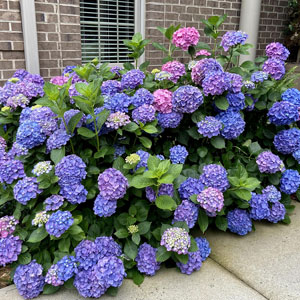
12Kviews
20 Wainscoting Panels For Your Home (And All The Info To Do It Right)
There’s a quiet elegance about a room adorned with wainscoting panels. They bring a timeless style, offering warmth and character to any space they grace.
But what exactly is wainscoting? Essentially, it’s a trio of components: wood panels, a framing element often referred to as chair railing, and molding. While today’s wainscoting typically covers only the lower part of the walls, back in the 18th century, it was common to see it extend from floor to ceiling.
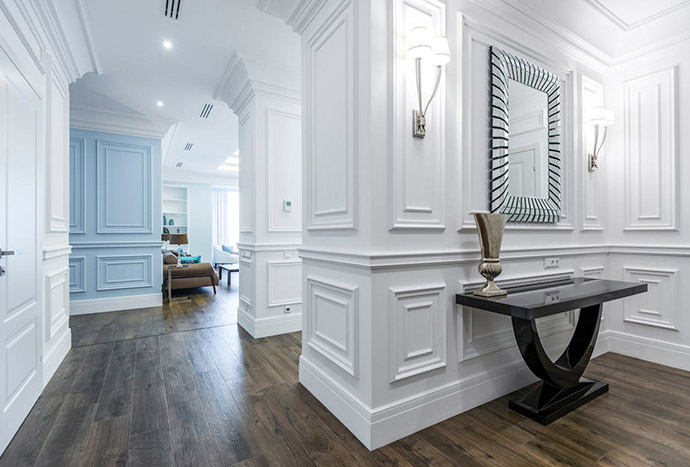
Image credits: Max Rahubovskiy
Originally, the goal behind wainscoting was pragmatic — offering a barrier against the chill and moisture of stone walls. These days, its decorative appeal often takes the spotlight, attracting homeowners because it’s just that good to look at.
The name “wainscoting” has an intriguing origin. It’s believed to have roots in the German word for “wall-board.” In its early days, the wood for this paneling was sourced from a tree called “wainscoting oak.” And even if the materials have changed, the term “wainscoting” has stuck around.
This guide is your companion through the allure of wainscoting in 2024 and beyond, the different panel types, and a selection of ideas for your next home project. We’ll also dig into the practical aspects of how to install wainscoting panels, ensuring you’re well-equipped to introduce this ageless style into your house.
Let’s roll up our sleeves and dive into a dose of inspiration and practical know-how as we venture through 20 wainscoting panels ideas and the knowledge on how to do it right!
- Is Wainscoting Still in Style in 2024?
- What Are the Different Types of Wainscoting Paneling?
- How Much Does a Sheet of Wainscoting Cost?
- Wainscoting Panels Ideas to Get Inspiration
- Wainscoting With Decorative Molding
- Colorful Wainscoting
- Two-Tone Wainscoting
- Wainscoting With Shelving
- Tall Wainscoting In Living Rooms
- Accent Wall Wainscoting
- Wainscoting In Unexpected Places
- Wainscoting With Wallpaper
- Wainscoting Ceiling
- Mirrored Wainscoting
- Rustic Reclaimed Wood Wainscoting
- Wainscoting With Hidden Storage
- Wainscoting As Headboard
- Farmhouse Style Wainscoting
- Wainscoting In The Dining Area
- Wainscoting With Geometric Patterns
- Picture Frame Wainscoting
- Metal Wainscoting
- Nautical Theme Wainscoting
- Gloss Finish Wainscoting
Is Wainscoting Still in Style in 2024?

Image credits: Alex Qian
First things first — yes, wainscoting is still in style. The beauty of wainscoting is that it’s like that cherished novel on your bookshelf: it never loses its essence, no matter how many times you revisit it.
In 2024, homeowners are finding inventive ways to incorporate this classic feature into contemporary settings. The versatility of wainscoting panels allows you to seamlessly blend them with various architectural and interior design styles.
Moreover, the sustainability aspect of wood wainscoting panels resonates with the eco-conscious mindset of many homeowners today. Opting for reclaimed or sustainably sourced wood panels reflects a responsible choice towards the environment, merging aesthetic appeal with eco-friendliness.
Plus, with an abundance of colors, finishes, and designs available, wainscoting panels can be tailored to reflect your style and preferences, making them a beloved choice for those looking to infuse a dose of character into their living spaces.
What Are the Different Types of Wainscoting Paneling?
Wainscoting has a rich tradition dating back to historical times, yet its variety of styles keeps it fresh and modern even today. With each type comes a unique aesthetic and functionality that can enhance the charm and practicality of your home.
Let’s explore some popular types of wainscoting paneling that have stood the test of time and continue to win hearts in contemporary settings.
Raised Panel

Image credits: TrueGentDevotie
Raised panel wainscoting is a traditional style reminiscent of colonial days. The edges of each panel are beveled, creating a “raised” effect. Typically, these panels stand between 30 and 40 inches tall, but if you have higher ceilings, you can add a center rail to create two rows of panels, offering a more tailored look.
Flat Panel
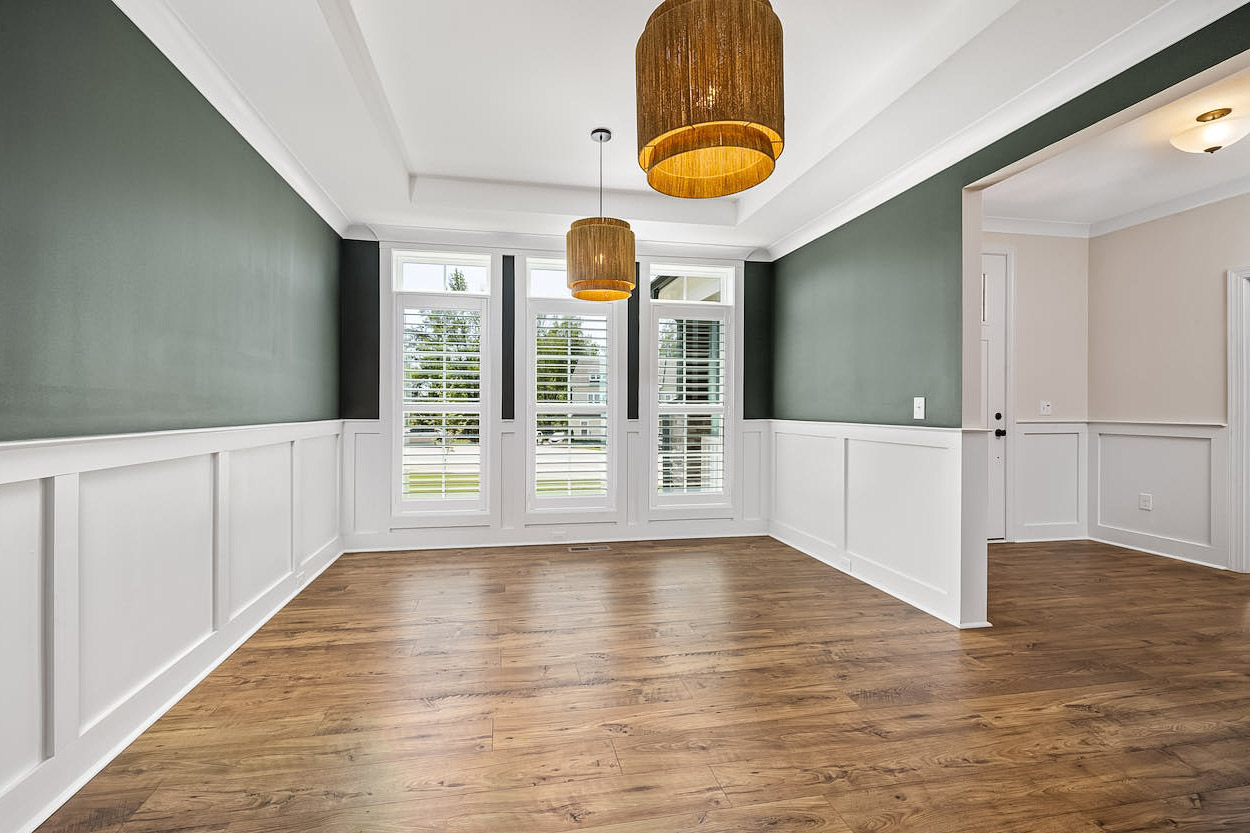 Image credits: Curtis Adams
Image credits: Curtis Adams
Flat panel wainscoting is a modern-day favorite. It features a smooth, flat wooden surface framed neatly, lending a clean and streamlined look to any room. It’s a simple yet sophisticated choice for those who appreciate contemporary design aesthetics.
Beadboard
Image credits: inprocorp
Beadboard wainscoting is characterized by vertical slats with small ridges or beads between them. It’s a casual style that brings a cozy feel to spaces like kitchens, bathrooms, or cottages, making rooms feel more inviting and homely.
Overlay
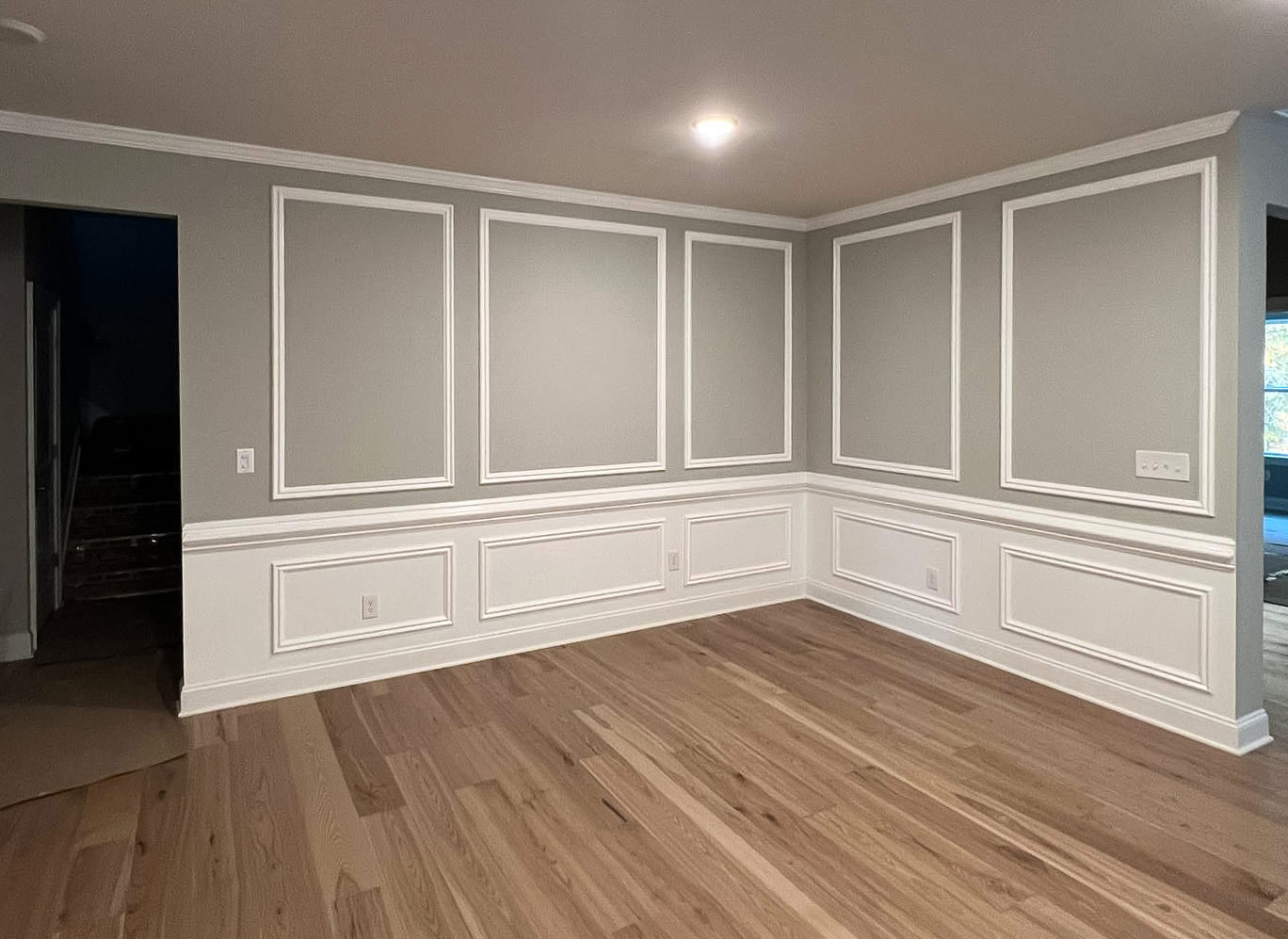
Image credits: olseninteriors
Overlay wainscoting involves placing panels on top of the existing wall surface. This design creates a layered look, adding a bit of depth and character to the room. It’s a unique style that can help delineate spaces or add a touch of elegance to plain walls.
Board and Batten
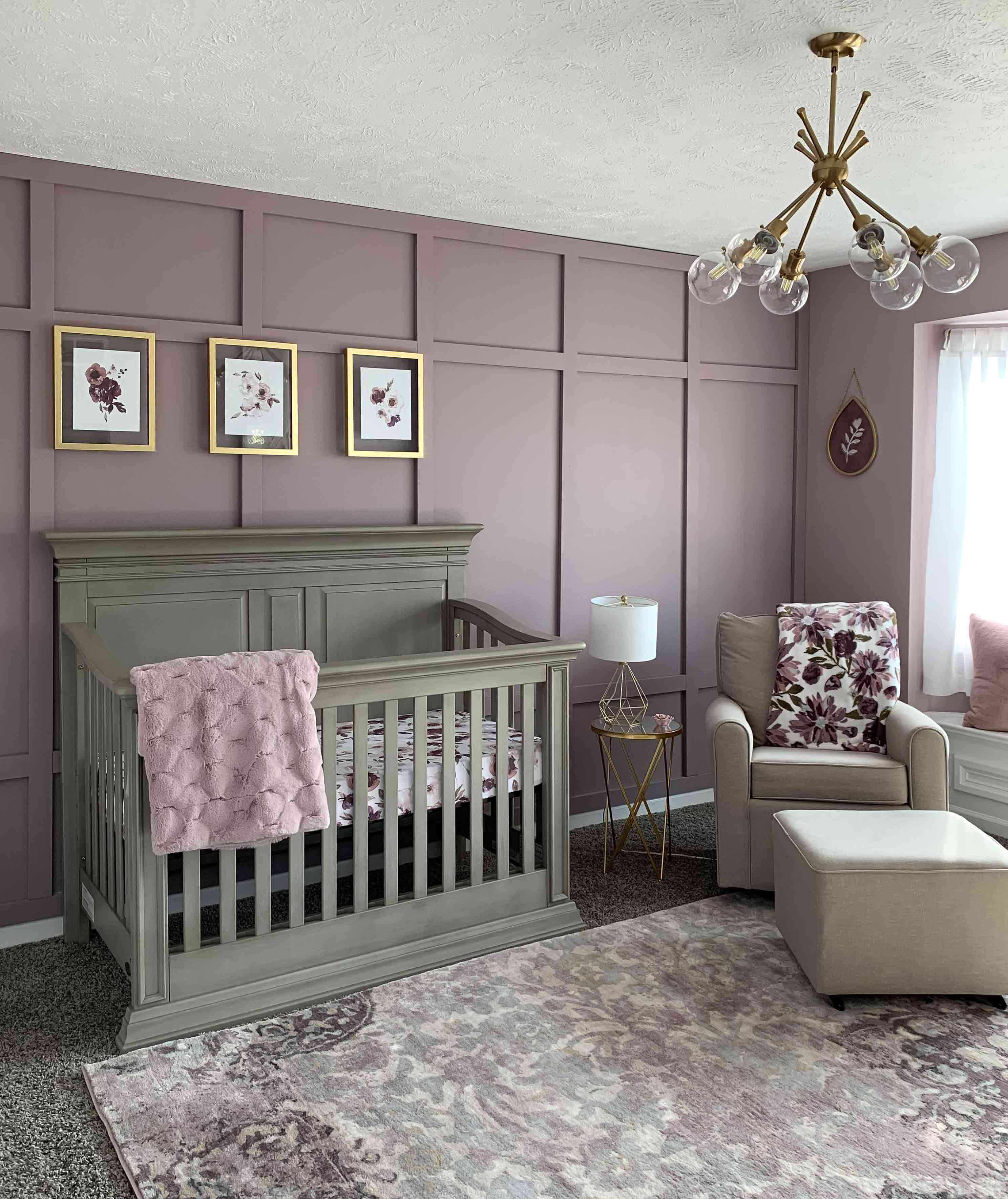
Image credits: PartTimePOG
Board and batten wainscoting features vertical battens placed over the seams between vertical boards. This design creates a geometric, three-dimensional effect that can add a rustic or craftsman appeal to a room. It’s a visually interesting style that also adds texture to your walls.
How Much Does a Sheet of Wainscoting Cost?
When it comes to cost, the price of wainscoting is usually calculated in square feet and varies widely depending on the material, type of panel, and quality. According to HomeAdvisor, you can expect to spend anywhere from $7 to $40 per square foot, with more ornate designs or premium woods costing more. Always keep in mind that while the panels themselves are a cost factor, so are the tools and supplies you’ll need for installation if you decide to do it all by yourself.
So, are you ready to make your room look good with wainscoting?
Wainscoting Panels Ideas to Get Inspiration
This post may include affiliate links.
Wainscoting With Decorative Molding
The intricate details of molding add a layer of sophistication, creating a rich and refined look. It’s a classic approach that pays homage to traditional design while adding a touch of luxury to your space.
Colorful Wainscoting
This idea is perfect for those who love to fill their spaces with vibrant energy. You can choose a bold color that contrasts with your walls or a palette of colors for a more playful effect. Colorful wainscoting not only adds visual interest but also showcases your personality in a fun and unique way.
Two-Tone Wainscoting
Two-tone wainscoting is a stylish choice for those who appreciate a sleek yet dynamic look. This design uses two different colors or shades, usually a darker color on the bottom and a lighter one on top. It’s a great way to add depth and dimension to a room without overwhelming the space.
Wainscoting With Shelving
Combining wainscoting with shelving is both aesthetic and functional. It’s an innovative way to create additional storage space while maintaining a clean and organized look. The shelves can be used to display your favorite books, decorative pieces, or even indoor plants, making the room feel lively and truly yours.
Tall Wainscoting In Living Rooms
Tall wainscoting adds a touch of elegance and grandeur to living rooms. By extending the wainscoting panels higher up the wall, you create a sense of height and spaciousness. It’s a sophisticated design choice that can make your living room feel more luxurious and well-designed.
Accent Wall Wainscoting
Accent wall wainscoting is a fantastic way to highlight a particular wall or area in a room. By using wainscoting panels with distinctive designs or colors, you can create a focal point that draws the eye and adds a touch of elegance. It’s great to break the monotony of plain walls and introduce a stylish feature in your home.
Wainscoting In Unexpected Places
Who said wainscoting only belongs on walls? Explore its potential by placing it in unexpected places like the sides of a kitchen island, along staircases, or even on the face of a bar counter. It’s a fantastic way to extend the classic charm of wainscoting beyond the usual spots.
Wainscoting With Wallpaper
Pairing wainscoting with wallpaper is a splendid idea for those who love a rich, colorful experience. The combination of solid wood panels below and wallpaper above creates a delightful contrast, adding layers of visual interest to your space.
Wainscoting Ceiling
Turn things upside down by installing wainscoting on the ceiling! It’s a bold move that pays off by creating a distinctive, eye-catching design element. This version of wainscoting can work particularly well in rooms with high ceilings.
Mirrored Wainscoting
Mirrored wainscoting is a spectacular way to add a touch of glamour and expand the perceived space of a room. The reflective panels catch the light beautifully, creating a bright and airy ambiance. It’s a fabulous choice for small areas or rooms lacking natural light.
Rustic Reclaimed Wood Wainscoting
Embrace the beauty of wood wainscoting with aged rustic reclaimed wood. The weathered look of reclaimed wood panels brings a touch of rustic charm, making each wall tell a story. It’s not only a style statement but also an eco-friendly choice that gives old wood a new life.
Wainscoting With Hidden Storage
Wainscoting with hidden storage is a clever way to keep your space tidy while maintaining a stylish appearance. The panels can be designed to conceal cabinets or shelves, offering a neat solution for storing away items. It’s a perfect blend of aesthetics and functionality, especially in rooms where space is at a premium.
Wainscoting As Headboard
Transform your bedroom with a wainscoting headboard. It’s a unique and budget-friendly idea to bring a touch of sophistication to your sleeping space. The textured or paneled design of wainscoting provides a charming backdrop for your bed, creating a cozy and inviting atmosphere.
Farmhouse Style Wainscoting
The charm of farmhouse-style wainscoting is a heartwarming addition to any home. Often painted in warm, neutral colors or left in a natural wood finish, this style creates a homely and welcoming aura. It’s a timeless choice that complements other farmhouse or country-inspired decor elements beautifully.
Wainscoting In The Dining Area
Wainscoting in the dining area adds a dash of grace to your mealtime. It creates a defined, elegant space that enhances the dining experience. Whether it’s a classic beadboard or a modern flat panel style, wainscoting brings a sense of occasion to every meal shared with loved ones.
Wainscoting With Geometric Patterns
Introducing geometric patterns to wainscoting panels is a modern twist on a classic. It’s a way to add a lively, energetic vibe to a room. The angular lines or circular patterns create a visual intrigue that’s both contemporary and fun.
Picture Frame Wainscoting
Picture frame wainscoting creates a sophisticated look by using moldings to form “frames” on the wall. These frames add an architectural interest to the room, presenting a classic and well-tailored look. It’s a design that adds character and a touch of elegance, making any room feel more refined and polished.
Metal Wainscoting
Far from the conventional wood paneling, this metal variation is durable and offers a fresh twist on the classic design element. The corrugated texture adds depth and character, while the metallic sheen gives the room a modern yet rugged look.
Nautical Theme Wainscoting
Bring the serene vibes of the seaside to your home with nautical-themed wainscoting. Using shades of blue, white, or even a weathered wood finish, you can create a calming coastal look. It’s a fresh and airy style that’s perfect for bathrooms, sunrooms, or seaside homes.
Gloss Finish Wainscoting
Gloss finish wainscoting is a sleek and polished choice. The shiny finish provides a clean, modern look while also making the room feel brighter and more spacious. It pairs well with modern decor, offering a refined and chic aesthetic.
Is Wainscoting Good For Every Room?
Image credits: Max Rahubovskiy
Wainscoting is a versatile design element that finds a cozy home in many rooms. It’s a common sight in dining rooms, family rooms, hallways, foyers, and even powder rooms, lending a tasteful flair and a comforting sense of warmth.
While traditionally seen in classic-style homes, wainscoting has also made its way into modern settings. Especially in high-traffic areas like entryways and stairways, it serves a practical purpose by guarding your walls against scuffs and marks, proving its value in aesthetics and functionality.
When Should You Not Use Wainscoting?
However, wainscoting isn't a one-size-fits-all solution. Spaces with unconventional shapes, such as L-shaped layouts, archways, or curved walls, may pose some challenges during installation, making wainscoting a less favorable option. Similarly, in smaller rooms or those with low ceilings, high wainscoting could potentially cramp the space further.
Wainscoting might also not be the go-to choice in rooms with high humidity levels, like bathrooms, unless you opt for moisture-resistant materials. Lastly, a room with more windows than wall space might not offer the right backdrop for wainscoting to truly shine.
What Rooms Should Have Wainscoting?
On the flip side, when placed thoughtfully, wainscoting can be a beautiful addition to many areas in your home. Dining rooms, living rooms, and hallways are the traditional havens for wainscoting. It adds a cozy and sophisticated touch in bedrooms, and when extended to home offices, libraries, or even kitchens, wainscoting carries a dash of classic charm and character.
The key is a thoughtful consideration of the room’s dimensions, existing decor, and the desired result. With these in mind, you can decide where this timeless design feature fits best, enhancing the appeal and comfort of your home.
How to Install Wainscoting Panels
Image credits: mgc213717
The process of installing wainscoting panels isn’t overly complex. Still, it does require some attention to detail and a bit of elbow grease if you decide to skip the professional help.
1. Decide on the Style and Height
First, you’ll want to take a look at which wainscoting best fits your space. Once that’s settled, the adventure begins with measuring your walls. This is crucial, as the old saying goes, “Measure twice, cut once.” This will save you from the headache of misaligned panels and unnecessary extra work.
2. Prepare the Walls
This next step might involve removing baseboards and ensuring your walls are smooth and ready for the panels to adhere to. Some people like to paint the walls and the back of the boards beforehand, especially if they’re going for a contrast look or want to ensure every nook and cranny is covered, but that’s up to your personal preference.
3. Cut the Panels
This is where your earlier measurements come into play. You’ll cut your boards to the necessary width and height, remembering to account for any outlets or switches. A saw will become your best friend during this step, and remember to don your safety gear!
4. Place Them on the Wall
With the panels cut, you’ll apply adhesive to the back of each one and place them firmly against the wall. Some also use nails for additional support. It’s like a puzzle, fitting each piece perfectly into its allotted space.
Finally, after all the panels are up, you’ll replace the baseboards or install new ones and add any additional trim or molding. This frames the wainscoting beautifully and gives it that finished look.
How Do You Make Wainscoting Look Good?
Making wainscoting look good is all about the harmony between the panels and the room they’re in. You want the wainscoting to feel like it’s always been a part of the space, not something that just showed up one day.
The first step is choosing the right type of wainscoting. You’ve got options like the simple elegance of the beadboard or the more formal raised panels.
Color is your next ally. Painting the wainscoting a shade that gently contrasts with the wall can set off the paneling beautifully. Think of a classic white against a soft-hued wall for an effortlessly chic look. But there’s room to play here! Going bold could mean having the wainscoting in a deep navy blue, adding both depth and drama to a space.
The devil is in the details, as they say. The finishing touches will make all the difference. This includes proper caulking and painting. Caulk fills in any gaps and seams, creating a seamless look, while a good paint job brings out the best in the paneling, showcasing the design and craftsmanship.
Ultimately, making wainscoting look good comes down to thoughtful selection and attention to detail. It’s these choices that take a room from just “nice” to magazine-worthy.
What is the Golden Rule for Wainscoting?
When it comes to wainscoting, there’s a timeless guideline often dubbed the Golden Rule — the height of wainscoting panels should be one-third the height of the room.
This isn't a strict law but more of a starting point to ensure that the wainscoting proportions are pleasing to the eye and in harmony with the space. When panels are too high, they can overwhelm a room, and when they’re too short, they may look stunted.
Image credits: Curtis Adams
Following this rule typically creates a balanced, classic aesthetic that feels just right. But remember, your home is your canvas — feel free to tweak this rule to suit your unique style and the character of your space. After all, rules are sometimes meant to be broken, especially in the name of creativity.
And speaking of creativity, let’s open the floor to you, the readers. Have you installed wainscoting in your home? What personal touches did you bring to the project? Did you stick to the golden rule or make your own? Share your experiences and tips in the comments below!
